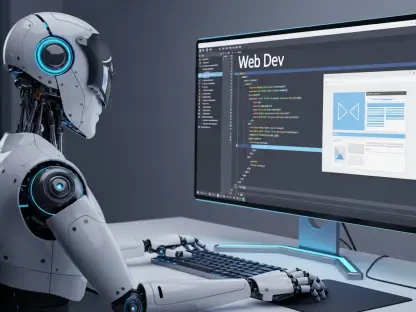In the fast-evolving realm of enterprise IT, a staggering 57% of organizations have spent over $1 million on DevOps platform migrations, only to find costs averaging 18% above budget, revealing a pressing challenge in the industry. The allure of rapid transformation through sweeping, all-at-once overhauls often leads to unexpected financial and operational pitfalls. As companies race to modernize software delivery pipelines to stay competitive, the complexities of these large-scale migrations, commonly known as big-bang approaches, are becoming impossible to ignore. This report delves into the hidden risks, human toll, and strategic missteps that accompany such ambitious projects, shedding light on why a rethink of modernization strategies is urgently needed in today’s tech-driven landscape.
Understanding the DevOps Migration Landscape
The DevOps ecosystem in enterprises is undergoing a profound shift as organizations prioritize modernization to enhance agility and scalability in software delivery. Platform migrations, which involve consolidating or replacing entire toolchains, have become a cornerstone of this transformation, driven by the need to integrate cloud-native solutions and streamline workflows. These initiatives are not merely technical upgrades but strategic imperatives to maintain a competitive edge in an increasingly digital market, where speed and reliability are paramount.
A comprehensive survey of over 300 IT and technology leaders highlights the scale and stakes of these migrations. The study captures a snapshot of an industry grappling with balancing innovation against stability, revealing how widespread the push for modernization has become. Key players in this space, including major platform vendors and enterprise adopters, are shaping the trajectory of DevOps through cutting-edge tools and practices, while technological advancements like automation and AI continue to accelerate the pace of change.
Amid this dynamic environment, the challenge lies in ensuring that operational continuity is not sacrificed for the sake of progress. Enterprises must navigate a delicate balance, adopting new systems without disrupting existing delivery cycles. This tension underscores the importance of strategic planning in migrations, as the consequences of missteps can ripple across entire organizations, impacting everything from product timelines to customer satisfaction.
The Realities of Big-Bang Migrations
Financial and Operational Pitfalls
Big-bang migrations, characterized by wholesale replacement of DevOps platforms in a single effort, often come with hefty financial burdens. Data shows that a majority of organizations—57%—have invested over $1 million in such projects, with expenses frequently exceeding initial budgets by an average of 18%. This overrun stems from underestimating the intricate web of dependencies within modern toolchains, which can delay timelines and inflate costs unexpectedly.
Beyond the monetary impact, these migrations wreak havoc on day-to-day operations. Downtime, compatibility conflicts, and the need to manage duplicate workloads during transitions disrupt regular workflows, stalling software delivery. The promise of streamlined processes through consolidation is often overshadowed by these interruptions, leaving teams struggling to maintain productivity while adapting to unfamiliar systems.
Hidden complexities further compound the problem, as interconnected tools reveal unforeseen challenges during implementation. These issues not only extend project durations but also divert critical resources from innovation to troubleshooting. The result is a frustrating paradox where efforts to accelerate delivery through modernization instead slow down progress, undermining the very goals that prompted the migration.
Human and Security Challenges
The human cost of big-bang migrations is equally concerning, with 70% of technology leaders noting a rise in developer burnout and declining morale. The intense cognitive load of learning new platforms while addressing production issues and meeting deadlines takes a significant toll on teams. This stress, if unaddressed, can lead to higher turnover rates, exacerbating talent shortages in an already competitive field.
Security risks also loom large in the aftermath of these overhauls, as 75% of organizations report difficulties in maintaining robust integrations post-migration. Visibility gaps in security systems, often tied to inadequate planning for data lineage or third-party compatibility, heighten vulnerability to threats. Such lapses can expose enterprises to substantial risks, undermining trust and operational integrity at a critical juncture.
These combined challenges—human strain and security gaps—create a ripple effect across the organization. Team retention suffers as morale dips, while the increased risk exposure from security shortcomings can lead to regulatory or reputational damage. Addressing these issues requires a holistic view of migration impacts, prioritizing both people and protection alongside technical goals.
Barriers to Successful DevOps Modernization
The path to effective DevOps modernization is fraught with obstacles, particularly when organizations opt for big-bang approaches. A primary barrier is the consistent underestimation of project complexity, as leaders fail to account for the intricate interplay of tools and processes in their ecosystems. This oversight often results in misaligned strategies that overlook critical dependencies, setting the stage for failure.
Technological hurdles add another layer of difficulty, with interoperability issues frequently arising during platform overhauls. Compatibility challenges between legacy systems and new solutions can derail migrations, creating bottlenecks that hinder progress. These technical mismatches demand significant rework, further straining resources and timelines in an already high-pressure environment.
External pressures, such as market competition and stringent compliance requirements, also push companies into rushed migrations, amplifying risks. While the drive to innovate and meet regulatory standards is understandable, the lack of a measured approach often backfires. Phased implementations, which allow for gradual adaptation and testing, emerge as a practical alternative to mitigate these barriers, fostering sustainable transformation without sacrificing stability.
Compliance and Security in Migration Strategies
Security and compliance stand as critical pillars in any DevOps migration, yet they are often sidelined in the rush of big-bang transitions. Post-migration challenges, such as disrupted security integrations, reveal how quickly vulnerabilities can emerge when these aspects are not prioritized. Without meticulous planning, organizations risk losing oversight of essential protective measures, leaving systems exposed.
Visibility gaps in security frameworks are particularly problematic, as they obscure potential threats during and after platform changes. Ensuring data lineage and compatibility with third-party tools must be embedded in migration strategies to prevent such blind spots. Neglecting these elements can lead to breaches or non-compliance with industry standards, both of which carry severe consequences.
Governance priorities are frequently at odds with the disruptive nature of big-bang migrations if security isn’t integrated from the outset. A proactive, compliance-focused approach to planning can significantly reduce risks, ensuring that transitions align with regulatory demands. By weaving these considerations into every stage of the process, enterprises can safeguard their operations while pursuing modernization goals.
The Future of DevOps Modernization
Looking ahead, a clear shift is emerging in the DevOps community toward incremental modernization as the preferred strategy. Industry consensus points to the limitations of sweeping overhauls, favoring instead a step-by-step evolution of specific capabilities or pipelines. This trend reflects a growing recognition that stability and progress can coexist with the right approach.
Emerging solutions are increasingly centered on interoperability, with vendors offering tools designed to support gradual transitions rather than disruptive replacements. Such innovations enable organizations to modernize without upending existing workflows, ensuring continuity. Additionally, enhanced vendor support for phased migrations is helping to ease the burden on internal teams, paving the way for smoother transformations.
Cultural adaptability and developer experience are also shaping the future of migration roadmaps. Prioritizing team well-being alongside technical upgrades is becoming a key focus, as is the need to align strategies with global economic conditions and innovation demands. These factors collectively suggest that the pace and style of DevOps transformations will continue to evolve, emphasizing balance over haste in the years ahead.
Key Takeaways and Recommendations
The findings from extensive industry research paint a sobering picture of big-bang migrations, revealing high financial costs, operational disruptions, and significant human impact. With costs often exceeding budgets by 18% and 70% of leaders reporting developer burnout, the drawbacks of this approach are evident. Security struggles, noted by 75% of organizations post-migration, further highlight the risks of inadequate preparation.
Incremental modernization stands out as a more effective path, with data indicating better team morale and performance metrics in phased implementations. This method allows for targeted improvements without the chaos of wholesale change, aligning with agile principles. Enterprises adopting this strategy report fewer disruptions and more consistent progress toward their goals.
Actionable steps for organizations include conducting thorough assessments of tool maturity before embarking on migrations and developing staged roadmaps for implementation. Emphasizing strategic alignment across leadership and technical teams can further ensure success. Ultimately, the DevOps ecosystem holds immense potential for balanced transformation, provided companies embrace pragmatic, sustainable strategies to navigate the complexities of modernization.









